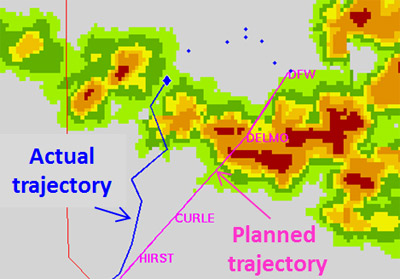Ask any airline pilot about their biggest frustration with modern air traffic control and management, and the answer will be inconsistent approach time or touch down time prediction. Pilots struggle to get updates in real time and are forced to constantly adapt their profile multiple times. Moreover in busy terminal airspaces where controller relies solely on radio communication it is difficult to get across a simple radio call at times.
Simply put: critical data does not reach fast enough to pilots, airlines and consumers (passengers).
The focus of advances in aviation has been to improve safety while at the same time reduce flight time, shorten routes, carry less fuel and reduce emissions. While aircraft avionics have advanced at a breakneck pace, Air Traffic Flow and Capacity Management (ATFCM) has not kept up – leading to delays, disruptions, and in some cases, dangerous midair confusion. Delays happen when traffic demand is more than traffic capacity. Air Navigation Service Providers (ANSP) have identified these issues and introduced measures like estimated off-block time (EOBT) or calculated take-off time (CTOT). It optimises departure sequence by absorbing delay at stands. However, when with in terminal airspace and while coming for landing, critical information like number in approach sequence or Expected Landing Time (ELDT) is not readily available to flight crew. This leads to aircraft flying suboptimal profile, delays, more fuel consumption and frequent changes in profile.
The question is why this information is not available to flight crew in real time. Is it too complicated to calculate the ELDT or the problems lies in method of communicating this information. We will answer these questions in this blog.
- As a passenger you would have used various apps to track your aircrft/flight position and likely arrival time. And you would naturally assume that such information would be available to Air Traffic Controllers also. The controllers have more precise information based on Radar (primary as well as secondary), ADSB (automatic dependent surveillance broadcasting) System, and Pilot reports.
- With advances in navigation and prediction tools it is possible to calculate EOBT and CTOT, it must be similarly possible to calculate Estimated Time of Arrival at Terminal Airspace Boundary and Expected Landing Time (ELDT). This information processing is data light and requires minimal processing.
- Using flight trajectory information, traffic, weather and fusing technology based on AI/ML it is possible to predict remaining flight trajectory based on own path and historical trajectory data. Based on this model ELDT can be computed. Like what is mentally done at present by controllers or flight crew which is subjective and depends on their experience. But once we have a model, it can be used at multiple locations and also be adapted based on local conditions.
- Next hurdle is communicating this information to pilot. When a pilot makes initial contact, the destination controller (ATC) provides information like runway in use, type of approach and routing to be followed. Similarly it should be mandatory to provide sequence and ELDT.
- Data link communication system (CPDLC) may also be used to communicate the same information. This will help pilots anticipate ATC commands, reducing communication over traditional radio which means more reliable transmissions and fewer miscommunications.
- Use of new technology will lead to more optimum routing, reduced delay, reduced communications and predictable descent profile. A Win Win for everyone.
As air travel demand increases and more systems are integrated like UAS and UAM, the goal should be clear: create an air traffic system that is as advanced as the avionics it serves. Until then, pilots will continue to face communication headaches in the cockpit, though relief may finally be on the horizon.
Be Safe. Fly Safe.



